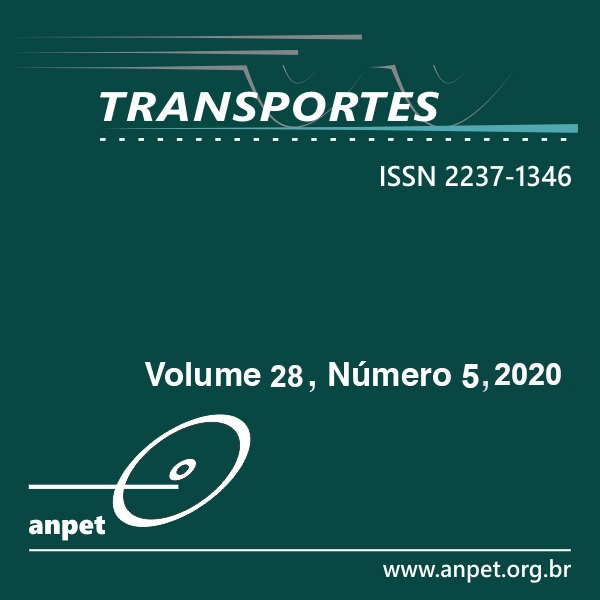Reflections on a scientific research program for roadway infrastructure in Brazil
DOI:
https://doi.org/10.14295/transportes.v28i5.2174Keywords:
Science. Research. Pavements. Infrastructure.Abstract
This paper is motivated by the transition between asphaltic pavement design methods in Brazil. The objective is to facilitate a method for knowledge revision that can be useful for future updates. It is presented an analysis of how Science, with its characteristics that makes it a paradigm of rationality when compared to other forms of comprehension and prediction, can affect a strategic area such as roadway infrastructure. A transforming moment of the sector in Brazil, with international funding, concessions, privatizations, require a national technical and scientific community equipped with the best available knowledge and with critical ability. Science moves us towards to what is believed to be truth in a given moment. In most cases, its application today exceeds predecessor methods. The reflection about Scientific Research Programs for roadway infrastructure is only one element to build an area at the frontiers of knowledge in both academia and innovation for businesses and the public sector.Downloads
References
Babadopulos, L.F.A.L.; Soares, J.B.; Castelo Branco, V.T.F. (2015) Interpreting fatigue tests in hot mix asphalt (HMA) using con-cepts from viscoelasticity and damage mechanics. Transportes v. 23, n. 2. DOI: https://doi.org/10.14295/transportes.v23i2.898.
Bastos, J.B.S.; silva, S.A.T.; Soares, J.B.; Nascimento, L.A.H.; KIM, Y.R. (2016) Triaxial stress sweep test protocol considerations for permanent deformation characterization of asphalt mixtures. RMPD, v. 19, n. 2. DOI: https://doi.org/10.1080/14680629.2016.1261729.
Chalmers, A.F. (2000) O que é Ciência afinal? Editora Brasiliense. ISBN: 8511120610.
Feyerabend, P. (1977) Contra o método. Editora Francisco Alves, RJ.
Flexner, A. (1939) The usefulness of useless knowledges. Princeton University Press. ISBN: 9780691174761.
Fritzen, M.A. (2016) Desenvolvimento e validação de função de transferência para previsão de dano por fadiga em pavimen-tos asfálticos. Tese de Doutorado. Programa de Engenharia Civil/COPPE/UFRJ.
SETRA/LCPC (1978) Guide technique. French Design Manual for Pavement Structures. LCPC et SETRA, Paris.
Lakatos, I. (1979) O falseamento e a metodologia dos programas de pesquisa científica. In: LAKATOS, I. e MUSGRAVE, A. A crítica e o desenvolvimento do conhecimento. São Paulo: Cultrix.
Khun, T.S. (1962) The structure of scientific revolutions. The University of Chicago Press.
Motta, L.M.G. (1991) Método de Dimensionamento de Pavimentos Flexíveis; Critério de Confiabilidade e Ensaios de Cargas Repetidas. Tese de Doutorado, UFRJ.
Motta, L.M.G.; Leite, L.F.M.; Franco, F.A.C.P.; Silva, C.F.S.C.; Medina, J. (2018) Execução de estudos e pesquisa para elaboração de método mecanístico - empírico de dimensionamento de pavimentos asfálticos. Convênio UFRJ/DNIT.
Nascimento, L.A.H. (2015) Implementation and Validation of the Viscoelastic Continuum Damage Theory for Asphalt Mixture and Pavement Analysis in Brazil. PhD Dissertation, North Carolina State University. USA.
Popper (1963) Conjectures and Refutations: The Growth of Scientific Knowledge.
Santiago, L.S.; Babadopulos, L.F.A.L.; Soares, J.B. (2019) Desenvolvimento de Função de Transferência para Previsão de Área Trincada em Pavimentos Asfálticos por Meio da Simulação do Dano por Fadiga Utilizando Modelo S-VECD e Análises Elásticas. Aceito para publicação. Transportes.
Soares, J.B.; Moreno, A.M.; Motta, L.M.G. (2009) Aspectos gerais de métodos de dimensionamento de pavimentos asfálticos de vários países e a relação com um novo método brasileiro. Revista Pavimentação, XVII.
Souza, M.L. (1981) Método de projeto de pavimentos flexíveis. 3ª ed. Rev. e Atual. RJ, IPR (Publ. 667).
Downloads
Published
How to Cite
Issue
Section
License
Authors who submit papers for publication by TRANSPORTES agree to the following terms:
- The authors retain the copyright and grant Transportes the right of first publication of the manuscript, without any financial charge, and waive any other remuneration for its publication by ANPET.
- Upon publication by Transportes, the manuscript is automatically licensed under the Creative Commons License CC BY 4.0 license. This license permits the work to be shared with proper attribution to the authors and its original publication in this journal.
- Authors are authorized to enter into additional separate contracts for the non-exclusive distribution of the version of the manuscript published in this journal (e.g., publishing in an institutional repository or as a book chapter), with recognition of the initial publication in this journal, provided that such a contract does not imply an endorsement of the content of the manuscript or the new medium by ANPET.
- Authors are permitted and encouraged to publish and distribute their work online (e.g., in institutional repositories or on their personal websites) after the editorial process is complete. As Transportes provides open access to all published issues, authors are encouraged to use links to the DOI of their article in these cases.
- Authors guarantee that they have obtained the necessary authorization from their employers for the transfer of rights under this agreement, if these employers hold any copyright over the manuscript. Additionally, authors assume all responsibility for any copyright infringements by these employers, releasing ANPET and Transportes from any responsibility in this regard.
- Authors assume full responsibility for the content of the manuscript, including the necessary and appropriate authorizations for the disclosure of collected data and obtained results, releasing ANPET and Transportes from any responsibility in this regard.









